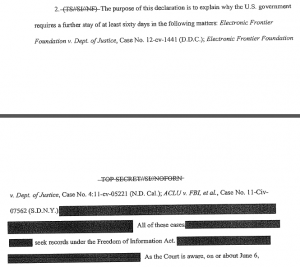Imagine the Informants You Can Coerce When You Can Spy on Every Single American
Please consider supporting my fundraiser so I can continue to do this kind of work.
Two years ago, I noted a chilling exchange from a 2002 FISA suit argued by Ted Olson. Laurence Silberman was trying to come up with a scenario in which some criminal information might not have any relevance to terrorism. When he suggested rape, Olson suggested we might use evidence of a rape to get someone to inform for us.
JUDGE SILBERMAN: Try rape. That’s unlikely to have a foreign intelligence component.
SOLICITOR GENERAL OLSON: It’s unlikely, but you could go to that individual and say we’ve got this information and we’re prosecuting and you might be able to help us.
It’s chilling not just because it suggests rapists have gone free in exchange for trumping up terrorist cases for the government, but because it makes clear the kinds of dirt the government sought using — in this case — traditional FISA wiretaps.
Now consider this passage from the government’s 2009 case that it should be able to sustain the Section 215 dragnet.
Specifically, using contact chaining [redacted] NSA may be able to discover previously unknown terrorist operatives, to identify hubs or common contacts between targets of interest who were previously thought to be unconnected, and potentially to discover individuals willing to become U.S. Government assets.
Remember, while the government downplayed this fact, until Barack Obama won the 2008 election, the government permitted analysts to contact chain off of 27,090 identifiers, going deeper than 3 hops in. That very easily encompasses every single American.
The ability to track the relationships of every single American, and they were using it to find informants.
In the 7 years since this program (now allegedly scaled back significantly, but still very very broad) has existed, the dragnet has only helped, however indirectly, to capture 12 terrorists in the US (and by terrorist, they also include people sending money to protect their country against US-backed invasion).
Which means the real utility of this program has been about something else.
The ability to track the relationships of every single American. And they were using it to find informants.
Even while the number of terrorists this program discovered has been minimal, the number of FBI informants has ballooned, to 15,000. And those informants are trumping up increasingly ridiculous plots in the name of fighting terrorism.
The ability to track the relationships of every single American (or now, a huge subset of Americans, focusing largely on Muslims and those with international ties). And they were (and presumably still are) using it to find informants.
Update: Note how in Keith Alexander’s description of the alert list, the standard to be on it is “the identifier is likely to produce information of foreign intelligence value” that are “associated with” one of the BR targets (Alexander 33). This is very similar to the language Olson used to justify getting data that didn’t directly relate to terrorism.
Also note this language (Alexander 34):
In particular, Section 1.7(c) of Executive Order 12333 specifically authorizes NSA to “Collect (including through clandestine means), process, analyze, produce, and disseminate signals intelligence information for foreign intelligence and counterintelligence purposes to support national and departmental missions.” However, when executing its SIGINT mission, NSA is only authorized to collect, retain or disseminate information concerning United States persons in accordance with procedures approved by the Attorney General.
Again, this emphasizes a foreign intelligence and CI purpose for collection that by law is limited to terrorism. Which could mean they think they can collect info to coerce people to turn informant.
The AG guidelines on informants are, not surprisingly, redacted.

